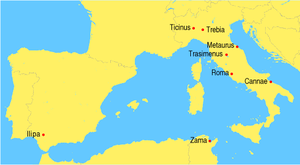Battle of Baecula
| Battle of Baecula | |||||||
|---|---|---|---|---|---|---|---|
| Part of the Second Punic War | |||||||
 | |||||||
| |||||||
| Belligerents | |||||||
| Carthage | Roman Republic | ||||||
| Commanders and leaders | |||||||
| Hasdrubal Barca | Scipio Africanus Major | ||||||
| Strength | |||||||
| 25,000 men, Carthaginian and Spaniards | 35,000 men, Roman | ||||||
| Casualties and losses | |||||||
| approx. 6,000 killed, 10,000 captured | Unknown | ||||||
The Battle of Baecula was Scipio Africanus’s first major field battle after he had taken command of Roman interests in Spain during the Second Punic War, in which he routed the Carthaginian army under the command of Hasdrubal Barca.
Prelude
After Scipio’s surprise attack and capture of Carthago Nova, the three Carthaginian armies in Spain remained separated, and their generals at odds with each other, thus giving the Romans a chance to deal with them one by one.
Early in 208 BC, Scipio moved against Hasdrubal, whose force wintered at Baecula, on the upper reached of the river Baetis (modern day Guadalquiver).
Upon learning the approach of the Romans, Hasdrubal shifted his camp to a strong defensive position — a high and deep plateau south of Baecula, protected by ravines on the flanks and the river to the front and rear. Moreover the plateau was formed into two steps, on which Hasdrubal posted his light troops on the lower one and his main camp behind.
After his arrival, Scipio at first was uncertain how to attack such a formidable position, but concerned that the other two Carthaginian armies might take advantage of his inaction and join with Hasdrubal, he took action on the third day.
Battle
Before his main attack, Scipio sent one detachment to block the entrance to the valley separating the two armies and one to the road leading north to Baecula, thus providing security to his main force while harassing any Carthaginian attempt to retreat.
After these preliminary deployments were done, the Roman light troops advanced against their Carthaginian counterparts on the first step. Despite the steep slope and under a shower of missile attack, the Romans had little difficulty driving back the Carthaginian light troops once they got into hand to hand combat.
After reinforcing his leading force, Scipio derived a pincer attack on the flanks of the Carthaginian main camp, by ordering Gaius Laelius to lead half of the remaining heavy foot to the right of the enemy position, and he himself scaling the left.
Hasdrubal, meanwhile, was under the impression that the Roman attack was only a skirmish (Scipio had hidden his main army in camp until the final attack), failed to properly deploy his main force, thus his ill-prepared army was caught on three sides by the Romans.
Despite being trapped, Hasdrubal was able to retreat unmolested with his elephants, his main baggage train, and most of his Carthaginian troops. It appeared that his main losses in the battle were most of his light troops and Spanish allies. This was largely due to the legionnarie's choice to plunder the Carthaginian camp rather than pursue Hasdrubal with any earnestness.
Aftermath
After the battle, Hasdrubal led his depleted army over the western passes of the Pyrenees into Gaul, and subsequently into Italy with a mostly Gallic force in an ill-fated attempt to join his brother Hannibal.
Many historians criticized Scipio in letting Hasdrubal escape from Spain. But a pursuit by the Romans, through unknown, mountainous, and hostile terrains, while leaving two full strength and numerously superior Carthaginian armies to his rear, would risk another disaster like the Battle of Lake Trasimene, and highly foolish.
Instead, Scipio retired his army to Tarraco, and managed to secure alliances with most of the Spanish tribes, who switched side after the Roman successes in Carthago Nova and Baecula.
Meanwhile, Carthaginian reinforcements landed in Spain during the winter, and would soon launch a final attempt to recover their losses.
References
- B.H. Liddell Hart; Scipio Africanus: greater than Napoleon; 1926; ISBN 0-306-80583-9
- Nigel Bagnall; The Punic Wars; 1990; ISBN 0-312-34214-4
- Polybius; The Rise of the Roman Empire; Trans. Ian Scott-Kilvert; 1979; ISBN 0-140-44362-2
- Serge Lancel; Hannibal; Trans. Antonia Nevill; 2000; ISBN 0-631-21848-3
